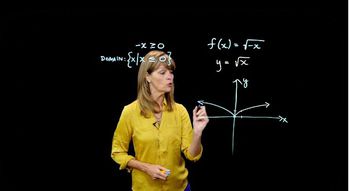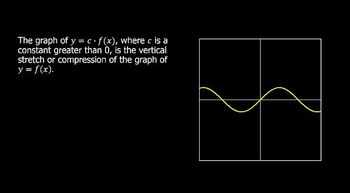Table of contents
- 0. Review of Algebra4h 16m
- 1. Equations & Inequalities3h 18m
- 2. Graphs of Equations43m
- 3. Functions2h 17m
- 4. Polynomial Functions1h 44m
- 5. Rational Functions1h 23m
- 6. Exponential & Logarithmic Functions2h 28m
- 7. Systems of Equations & Matrices4h 6m
- 8. Conic Sections2h 23m
- 9. Sequences, Series, & Induction1h 19m
- 10. Combinatorics & Probability1h 45m
3. Functions
Transformations
Problem 66a
Textbook Question
In Exercises 64–66, begin by graphing the square root function, f(x) = √x. Then use transformations of this graph to graph the given function. r(x) = 2√(x + 2)
 Verified step by step guidance
Verified step by step guidance1
Start by graphing the basic square root function, f(x) = \sqrt{x}. This graph starts at the origin (0,0) and increases gradually, forming a curve that gets less steep as x increases.
Next, consider the transformation for the function r(x) = 2\sqrt{x + 2}. The term (x + 2) inside the square root indicates a horizontal shift. Specifically, the graph of \sqrt{x} will shift 2 units to the left.
After shifting the graph 2 units to the left, the function becomes \sqrt{x + 2}. Now, apply the vertical stretch. The coefficient 2 outside the square root function means that every y-value of \sqrt{x + 2} will be multiplied by 2.
To graph r(x) = 2\sqrt{x + 2}, take the graph of \sqrt{x + 2} and stretch it vertically by a factor of 2. This means that if a point (a, b) is on the graph of \sqrt{x + 2}, then the point (a, 2b) will be on the graph of r(x).
Plot the transformed points and draw the new curve. The new graph will start at the point (-2, 0) and follow the shape of the original square root function, but it will be stretched vertically.
Recommended similar problem, with video answer:
 Verified Solution
Verified SolutionThis video solution was recommended by our tutors as helpful for the problem above
Video duration:
6mPlay a video:
Was this helpful?
Key Concepts
Here are the essential concepts you must grasp in order to answer the question correctly.
Square Root Function
The square root function, denoted as f(x) = √x, is a fundamental mathematical function that returns the non-negative square root of x. Its graph is a curve that starts at the origin (0,0) and increases gradually, remaining in the first quadrant. Understanding this function is crucial as it serves as the base for transformations in the given problem.
Recommended video:

Imaginary Roots with the Square Root Property
Transformations of Functions
Transformations of functions involve shifting, stretching, compressing, or reflecting the graph of a function. In this case, the function r(x) = 2√(x + 2) involves a horizontal shift to the left by 2 units and a vertical stretch by a factor of 2. Mastery of these transformations allows for the accurate graphing of modified functions based on their parent functions.
Recommended video:

Domain & Range of Transformed Functions
Graphing Techniques
Graphing techniques include plotting key points, understanding the shape of the function, and applying transformations. For the function r(x), one must first graph the base function f(x) = √x, then apply the transformations to find the new graph. This process is essential for visualizing how changes in the function's equation affect its graphical representation.
Recommended video:
Guided course

Graphs and Coordinates - Example

 5:25m
5:25mWatch next
Master Intro to Transformations with a bite sized video explanation from Nick Kaneko
Start learningRelated Videos
Related Practice

























